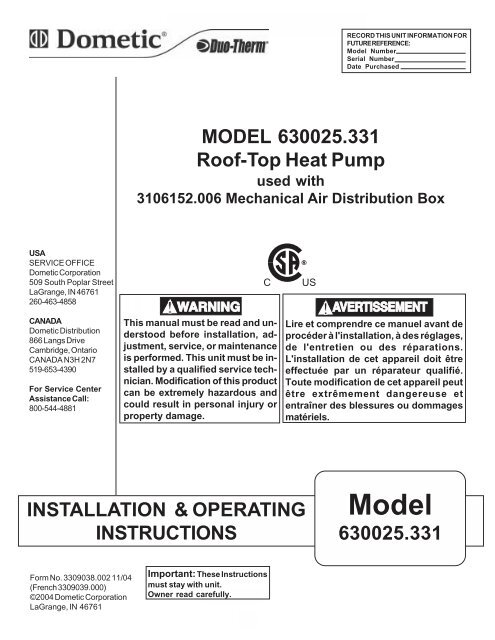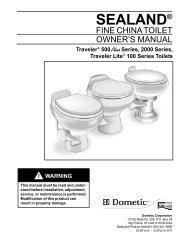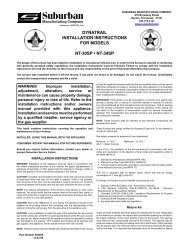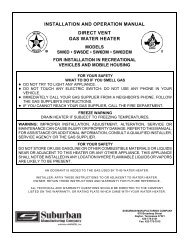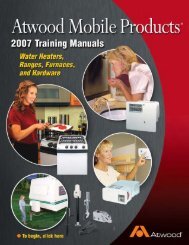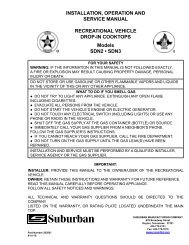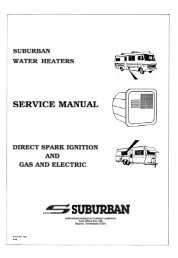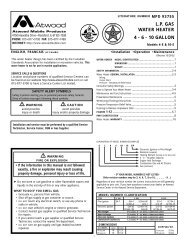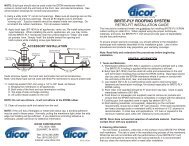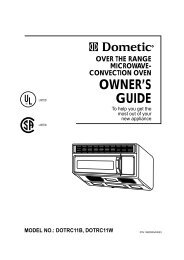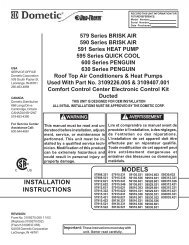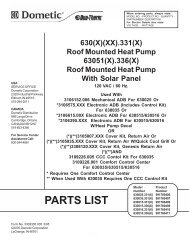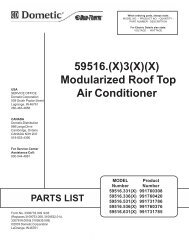Dometic Duotherm Brisk Air Conditioner 630025 Heat Pump
Dometic Duotherm Brisk Air Conditioner 630025 Heat Pump
Dometic Duotherm Brisk Air Conditioner 630025 Heat Pump
- No tags were found...
You also want an ePaper? Increase the reach of your titles
YUMPU automatically turns print PDFs into web optimized ePapers that Google loves.
RECORD THIS UNIT INFORMATION FOR<br />
FUTURE REFERENCE:<br />
Model Number<br />
Serial Number<br />
Date Purchased<br />
MODEL <strong>630025</strong>.331<br />
Roof-Top <strong>Heat</strong> <strong>Pump</strong><br />
used with<br />
3106152.006 Mechanical <strong>Air</strong> Distribution Box<br />
USA<br />
SERVICE OFFICE<br />
<strong>Dometic</strong> Corporation<br />
509 South Poplar Street<br />
LaGrange, IN 46761<br />
260-463-4858<br />
CANADA<br />
<strong>Dometic</strong> Distribution<br />
866 Langs Drive<br />
Cambridge, Ontario<br />
CANADA N3H 2N7<br />
519-653-4390<br />
For Service Center<br />
Assistance Call:<br />
800-544-4881<br />
This manual must be read and understood<br />
before installation, adjustment,<br />
service, or maintenance<br />
is performed. This unit must be installed<br />
by a qualified service technician.<br />
Modification of this product<br />
can be extremely hazardous and<br />
could result in personal injury or<br />
property damage.<br />
C<br />
US<br />
Lire et comprendre ce manuel avant de<br />
procéder à l'installation, à des réglages,<br />
de l'entretien ou des réparations.<br />
L'installation de cet appareil doit être<br />
effectuée par un réparateur qualifié.<br />
Toute modification de cet appareil peut<br />
être extrêmement dangereuse et<br />
entraîner des blessures ou dommages<br />
matériels.<br />
INSTALLATION & OPERATING<br />
INSTRUCTIONS<br />
Model<br />
<strong>630025</strong>.331<br />
Form No. 3309038.002 11/04<br />
(French 3309039.000)<br />
©2004 <strong>Dometic</strong> Corporation<br />
LaGrange, IN 46761<br />
Important: These Instructions<br />
must stay with unit.<br />
Owner read carefully.<br />
1
<strong>630025</strong>.331 Installation Instructions<br />
SAFETY INSTRUCTIONS<br />
This manual has safety information and instructions<br />
to help users eliminate or reduce the risk of<br />
accidents and injuries.<br />
RECOGNIZE SAFETY INFORMATION<br />
!<br />
This is the safety-alert symbol. When you see this<br />
symbol in this manual, be alert to the potential for<br />
personal injury.<br />
Follow recommended precautions and safe operating<br />
instructions.<br />
UNDERSTAND SIGNAL WORDS<br />
A signal word , WARNING OR CAUTION is used<br />
with the safety-alert symbol. They give the level of<br />
risk for potential injury.<br />
! WARNING indicates a potentially hazardous<br />
situation which, if not avoided, could result in<br />
death or serious injury.<br />
!<br />
CAUTION<br />
indicates a potentially hazardous<br />
situation which, if not avoided may result in<br />
minor or moderate injury.<br />
CAUTION used without the safety alert<br />
symbol indicates, a potentially hazardous situation<br />
which, if not avoided may result in property<br />
damage.<br />
Read and follow all safety information and instructions.<br />
GENERAL INFORMATION<br />
A. Product features or specifications as described or illustrated<br />
are subject to change without notice.<br />
B. This <strong>Air</strong> <strong>Conditioner</strong> Is Designed For:<br />
1. Installation on a recreational vehicle during the time<br />
the vehicle is manufactured.<br />
2. Mounting on the roof of a recreational vehicle.<br />
3. Roof construction with rafters/joists on minimum of 16<br />
inch centers.<br />
4. Minimum of 2.00 inches and maximum of 4.00 inches<br />
distance between roof to ceiling of recreational vehicle.<br />
Alternate installation methods will allow for roofs more<br />
than 4.00 inches thick.<br />
C. The ability of the air conditioner to maintain the desired<br />
inside temperature depends on the heat gain of the RV.<br />
Some preventative measures taken by the occupants of the<br />
RV can reduce the heat gain and improve the performance of<br />
the air conditioner. During extremely high outdoor temperatures,<br />
the heat gain of the vehicle may be reduced by:<br />
1. Parking the RV in a shaded area<br />
2. Using window shades (blinds and/or curtains)<br />
3. Keeping windows and doors shut or minimizing usage<br />
4. Avoiding the use of heat producing appliances<br />
Operation on High Fan/Cooling mode will give optimum or<br />
maximum efficiency in high humidity or high outside temperatures.<br />
Starting the air conditioner early in the morning and giving it a<br />
"head start" on the expected high outdoor ambient will greatly<br />
improve its ability to maintain the desired indoor temperature.<br />
For a more permanent solution to high heat gain, accessories like<br />
A&E outdoor patio and window awnings will reduce heat gain by<br />
removing the direct sun. They also add a nice area to enjoy<br />
company during the cool of the evening.<br />
D. Condensation<br />
Note: The manufacturer of this air conditioner will not be responsible<br />
for damage caused by condensed moisture on ceilings or<br />
other surfaces. <strong>Air</strong> contains moisture and this moisture tends to<br />
condense on cold surfaces. When air enters the RV, condensed<br />
moisture may appear on the ceiling, windows, metal parts, etc.<br />
The air conditioner removes this moisture from the air during<br />
normal operation. Keeping doors and windows closed when this<br />
air conditioner is in operation will minimize condensed moisture<br />
on cold surfaces.<br />
2
<strong>630025</strong>.331 Installation Instructions<br />
SPECIFICATIONS<br />
Model Nominal Electrical Compressor Compressor Fan Motor Fan Motor SCFM-High Total Refrigerant Minimum AC Circuit Installed Minimum<br />
No. Capacity Rating Rated Load Locked Rated Load Locked Speed Static R-22 (Oz.) Wire Size* Protection Weight Generator<br />
(BTU/HR) Amps Rotor Amps Rotor Max/Min Max/Min ***User (Pounds) Size**<br />
Cooling Amps Amps W.C. Supplied 1Unit/2Units<br />
<strong>630025</strong>.331 13,500 12.4 60.0 3.5 10.0 335 / 250 .012 / 0.65 23.5 20 Amp 99 3.5 KW / 5.0 KW<br />
120 VAC, 12AWG<br />
60 Hz., 1 PH Copper<br />
Up To 24'<br />
* For wire length over 24 ft., consult the National Electric Code for proper sizing.<br />
** <strong>Dometic</strong> Corporation gives GENERAL guidelines for generator requirements. These guidelines come from experiences people have had in actual applications.<br />
When sizing the generator, the total power usage of your recreational vehicle must be considered. Keep in mind generators lose power at high altitudes<br />
and from lack of maintenance.<br />
*** CIRCUIT PROTECTION: Time Delay Fuse or HACR Circuit Breakers Required.<br />
3
<strong>630025</strong>.331 Installation Instructions<br />
INSTALLATION INSTRUCTIONS<br />
A. Precautions<br />
b. For two unit installations: Install one <strong>Air</strong> <strong>Conditioner</strong><br />
1/3 and one <strong>Air</strong> <strong>Conditioner</strong> 2/3’s from<br />
front of RV and centered from side to side.<br />
FIG. 2<br />
Improper installation may damage equipment,<br />
could endanger life, cause serious injury and/<br />
or property damage.<br />
1/2L L<br />
L<br />
2/3L<br />
1/3L<br />
1. Read Installation and Operating Instructions carefully<br />
before attempting to start your air conditioner<br />
installation.<br />
2. <strong>Dometic</strong> Corporation will not be liable for any damages<br />
or injury incurred due to failure in following<br />
these instructions.<br />
3. Installation must comply with the National Electrical<br />
Code ANSI/NFPA-70 and CSA Standard C22.1<br />
(latest edition and any State or Local Codes or<br />
regulations.<br />
4. DO NOT add any devices or accessories to this air<br />
conditioner except those specifically authorized by<br />
<strong>Dometic</strong>.<br />
5. This equipment must be serviced by qualified personnel<br />
and some states require these people to be<br />
licensed.<br />
B. Choosing Proper Location For The <strong>Air</strong><br />
<strong>Conditioner</strong><br />
This air conditioner is specifically designed for installation on<br />
the roof of a recreational vehicle (RV). When determining your<br />
cooling requirements, the following should be considered:<br />
• Size of RV;<br />
• Window area (increases heat gain);<br />
• Amount of insulation in walls and roof;<br />
• Geographical location where the RV will be used;<br />
• Personal comfort level required.<br />
1. Normal Location-The air conditioner is designed to<br />
fit over an existing roof vent opening.<br />
It is preferred that the air conditioner be installed on a<br />
relatively flat and level roof section measured with the RV<br />
parked on a level surface.<br />
Note: A 8° slant to either side, or front to back, is acceptable<br />
for all units.<br />
3. After Location Has Been Selected:<br />
a. Check for obstructions in the area where air<br />
conditioner will be installed. See FIG. 3 & 4.<br />
b. The roof must be designed to support 130<br />
poundswhen the RV is in motion. Normally a<br />
200 lb. static load design will meet this requirement.<br />
CAUTION<br />
It is the responsibility of the installer of this<br />
air conditioner system to ensure structural integrity<br />
of the RV roof. Never create a low spot<br />
on the roof where water will collect. Water<br />
standing around the air conditioner may leak<br />
into the interior causing damage to the product<br />
and the RV.<br />
c. Check inside the RV for return air kit obstructions<br />
(i.e. door openings, room dividers, curtains,<br />
ceiling fixtures, etc.) See FIG. 3 & 4.<br />
FIG. 3<br />
FIG. 1<br />
9-1/2"<br />
9-1/2"<br />
28-3/4"<br />
28-3/4"<br />
39"<br />
39"<br />
2. Other Locations-When no roof vent is available or<br />
another location is desired, the following is recommended:<br />
a. For one unit installation: The air conditioner<br />
should be mounted slightly forward of center<br />
(front to back) and centered from side to side.<br />
20"<br />
2-1/2"<br />
22"<br />
4
<strong>630025</strong>.331 Installation Instructions<br />
FIG. 4<br />
4"<br />
7-1/8”<br />
4"<br />
FIG. 5<br />
4-1/8”<br />
14-1/4" x 14-1/4”<br />
(±1/8”) OPENING<br />
21-3/8”<br />
Center Line<br />
of Unit<br />
REAR<br />
OF<br />
UNIT<br />
7-1/8”<br />
KEEP THESE AREAS<br />
FREE OF OBSTRUCTIONS 12"<br />
4<br />
2 7/8<br />
2 7/8<br />
C. Roof Preparation<br />
1. Opening Requirements - Before preparing the ceiling<br />
opening, read all of the following instructions<br />
before beginning the installation.<br />
If a roof vent opening will not be used a 14-1/4" x 14-<br />
1/4" (±1/8") opening must be cut through the roof and<br />
ceiling of the RV. This opening must be located<br />
between the roof reinforcing members.<br />
There may be electrical wiring between the<br />
roof and the ceiling. Disconnect 120 volt AC<br />
power cord and the positive (+) 12 volt DC terminal<br />
at the supply battery. Failure to follow<br />
this instruction may create a shock hazard<br />
causing death or severe personal injury.<br />
The 14-1/4" x 14-1/4" (±1/8") opening is part of the<br />
return air system of the <strong>Air</strong> <strong>Conditioner</strong> and must<br />
be finished in accordance with NFPA Standard 501C<br />
Section 2.7.2.<br />
2. Roof Vent Removal<br />
a. Unscrew and remove the roof vent.<br />
b. Remove all caulking compound around opening.<br />
c. Seal all screw holes and seams where the roof<br />
gasket is located. Use a good grade of all<br />
weather sealant. See FIG. 5.<br />
4<br />
+ - 1/8<br />
d. If the opening exceeds 14-3/8" x 14-3/8", it will<br />
be necessary to re-size the opening to 14-1/4"<br />
x 14-1/4" (±1/8").<br />
e. If the opening is less than 14-1/8" x 14-1/8", it<br />
must be enlarged.<br />
3. New Opening- (Installation Other Than Vent Opening)<br />
a. Mark a 14-1/4" x 14-1/4" (±1/8") square on the<br />
roof and carefully cut the opening.<br />
b. Using the roof opening as a guide, cut the<br />
matching hole in the ceiling.<br />
c. The opening created must be framed to provide<br />
adequate support and prevent air from being<br />
drawn from the roof cavity. Lumber 3/4" or more<br />
in thickness must be used. Remember to provide<br />
an entrance hole for power supply.<br />
FIG. 6<br />
Do Not Cut<br />
Roof Structure<br />
Or Rafters<br />
3/4" Min.<br />
Leave Access For Power<br />
Supply Wiring<br />
Good-Rafters<br />
Supported By<br />
Cross Beams<br />
CAUTION<br />
Good Location-<br />
Between Roof<br />
Rafters<br />
Frame Opening So It<br />
Won't Collapse When<br />
Bolting Down Unit<br />
15" Min. At<br />
Front Of<br />
Opening<br />
It is the responsibility of the installer of this<br />
air conditioner system to ensure structural<br />
integrity of the RV roof. Never create a low<br />
spot on the roof where water will collect. Water<br />
standing around the air conditioner may<br />
leak into the interior causing damage to the<br />
product and the RV.<br />
5
<strong>630025</strong>.331 Installation Instructions<br />
D. Wiring Requirements<br />
1. 120 VAC Supply Line<br />
Route a copper 12 AWG, with ground, 120 VAC<br />
supply line from the time delay fuse or circuit breaker<br />
box to the roof opening.<br />
a. This supply line must be located in the front<br />
portion of the 14-1/4" x 14-1/4" (±1/8") opening.<br />
b. The power MUST be on a separate 20 Amp time<br />
delay fuse or HACR circuit breaker.<br />
c. Make sure that at least 15" of supply wire<br />
extends into the roof opening. This ensures and<br />
easy connection at the junction box.<br />
d. Wiring must comply with all National, State and<br />
Local Wiring Codes.<br />
e. Use a steel sleeve and a grommet or equivalent<br />
methods to protect the wire where it passes into<br />
the opening.<br />
4. Place the 3106152.006 Mechanical <strong>Air</strong> Distribution<br />
Box Kit. This box contains mounting hardware for the<br />
air conditioner and will be used inside the RV.<br />
This completes the outside work. Minor adjustments can<br />
be done from the inside of the RV if required.<br />
F. Installing The <strong>Air</strong> <strong>Conditioner</strong><br />
1. Remove air box and mounting hardware from carton.<br />
The upper duct is shipped inside the lower duct<br />
which is part of the ceiling template.<br />
2. Check for correct alignment and adjust the unit as<br />
necessary (Roof Gasket centers over 14-1/4" ±1/8"<br />
opening).<br />
3. Remove upper duct from ceiling template and locate<br />
it over blower discharge. See FIG.9.<br />
Note: Edge without flange installs toward REAR of opening.<br />
E. Placing <strong>Air</strong> <strong>Conditioner</strong> On The Roof<br />
FIG. 9<br />
Rear Of <strong>Air</strong><br />
<strong>Conditioner</strong><br />
This unit weighs approximately 100 pounds.<br />
To prevent back injury, use a mechanical hoist<br />
to place <strong>Air</strong> <strong>Conditioner</strong> on roof.<br />
1. Remove the air conditioner from the carton and discard<br />
carton. See FIG. 7.<br />
Upper Discharge<br />
<strong>Air</strong> Duct<br />
Edge Without<br />
Flange To<br />
Rear Of Unit<br />
FIG. 7<br />
2. Place the air conditioner on the roof.<br />
3. Lift and place the unit over the prepared opening using<br />
the gasket on the unit as a guide. See FIG. 8.<br />
FIG. 8<br />
FRONT<br />
4. Use two (2) sharp pointed #10 sheet metal screws<br />
to hold duct to base pan. Screw holes are provided<br />
in bottom of base pan for these screws.<br />
5. Reach up into return air opening of the air conditioner<br />
and pull the unit electrical cord down for later<br />
connection.<br />
6. Measure the ceiling to roof thickness:<br />
a. If distance is 1"-2", remove perforated tabs from<br />
both upper and lower ducts. See FIG. 10.<br />
b. If distance is 2"-3", remove perforated tabs from<br />
bottom duct only. See FIG. 10.<br />
c. If distance is 3"-4", install ducts as received.<br />
See FIG. 10.<br />
d. If distance is 4"-6", use optional 318556.000<br />
Duct Adaptor and 3100895.006 Bolt Kit. See<br />
FIG. 10.<br />
CAUTION<br />
Do not slide the unit. This may damage the<br />
roof gasket attached to the bottom and may<br />
create a leaky installation.<br />
FIG. 10<br />
Step a<br />
Remove At<br />
Perforation<br />
Step c<br />
Use As<br />
Packaged<br />
Upper Discharge<br />
<strong>Air</strong> Duct<br />
Step b<br />
Remove At<br />
Perforation<br />
Lower Discharge<br />
<strong>Air</strong> Duct<br />
6
<strong>630025</strong>.331 Installation Instructions<br />
7. Install ceiling template by sliding lower duct over<br />
upper duct. See FIG. 11.<br />
FIG. 11<br />
<strong>Air</strong> <strong>Conditioner</strong><br />
Return <strong>Air</strong><br />
Opening<br />
Slide Lower <strong>Air</strong><br />
Discharge Duct<br />
Over Upper Duct<br />
G. Wiring The System<br />
!<br />
WARNING<br />
Disconnect 120 volt AC. Failure to follow these<br />
instructions could create a shock hazard causing<br />
death or severe personal injury.<br />
Reach up into the return air opening and pull the remaining<br />
wires down.<br />
1. Connection of 120 VAC (refer to FIG. 12)<br />
Roof<br />
FIG. 12<br />
Route Power Supply<br />
Through Romex Connector<br />
Hold Ceiling Template With<br />
One Hand And Install 3<br />
Mounting Bolts Finger Tight<br />
8. Hold the ceiling template with one hand and with the<br />
other, install the three 1/4" mounting bolts through<br />
the template and into the base pan.<br />
a. Finger-tighten the bolts and check alignment.<br />
There should be an equal opening on each side<br />
and the rear flange must be tight against the roof<br />
opening.<br />
b. EVENLY tighten the three bolts to a torque<br />
of 40 to 50 inch pounds. This will compress<br />
the roof gasket to approximately 1/2". The<br />
bolts are self locking so over tightening is<br />
not necessary.<br />
CAUTION<br />
If bolts are left loose there may not be an adequate<br />
roof seal or if over tightened, damage<br />
may occur to the air conditioner base or ceiling<br />
template. Tighten to torque specifications<br />
listed in this manual.<br />
Install<br />
Cover<br />
Plug Conduit<br />
Into Switch<br />
Box<br />
a. Route power supply line through Romex connector<br />
into junction box. Tighten connector,<br />
being careful not to pinch or short wires.<br />
b. Connect white to white; black to black; and<br />
green to green or bare copper wire using appropriate<br />
sized twist connectors.<br />
c. Tape the twist wire connectors to the supply<br />
wire to assure they don't vibrate off.<br />
d. Push the wires into the box.<br />
e. Install the cover onto the junction box.<br />
f. Plug the electrical conduit from the upper unit<br />
into the mating switch box connector. See FIG.<br />
12.<br />
7
<strong>630025</strong>.331 Installation Instructions<br />
H. <strong>Air</strong> Distribution Box Installation<br />
1. Remove the two return air grills and filters.<br />
2. Slide the front end of the air box over the shafts of<br />
the thermostat and selector switch. See FIG.13.<br />
FIG. 13<br />
Slide <strong>Air</strong> Box over Controls<br />
3. Install four screws through legs in air box into the<br />
pre-punched holes in the ceiling template.<br />
4. Install the return air grills and filters by simply pushing<br />
them into place.<br />
5. Install the two knobs provided on the ends of the<br />
thermostat and selector switch shafts.<br />
6. The power supply to the air conditioner may now be<br />
turned “ON”.<br />
7. Your air conditioner is now installed and ready for<br />
operation. Please read the following instructions before<br />
attempting to run the unit.<br />
OPERATING INSTRUCTIONS<br />
A. Controls<br />
1. The Selector Switch has ten positions including<br />
"OFF". This controls fan speed, heating mode, and<br />
cooling modes. See FIG. 14.<br />
FIG. 14<br />
FAN<br />
HI<br />
LO<br />
MED<br />
HI<br />
MED<br />
OFF<br />
COOL<br />
LO<br />
HI<br />
MED<br />
HEAT<br />
LO<br />
Selector Switch<br />
2. The thermostat controls the compressor ON/OFF<br />
operation in cooling temperature range of 65° to<br />
90°F. See FIG. 15.<br />
FIG. 15<br />
3<br />
2<br />
WARM<br />
4<br />
HEAT PUMP<br />
5<br />
By DOMETIC<br />
6<br />
COOL<br />
B. Cooling Operation<br />
1. Set the thermostat at the desired temperature level.<br />
2. Select the fan speed that best satisfies your needs:<br />
a. HIGH COOL: Selected when maximum cooling<br />
and dehumidification required.<br />
b. MED COOL: Selected when normal or average<br />
cooling required.<br />
c. LOW COOL: Selected when room at desired<br />
comfort level and needs to be maintained.<br />
Normally this speed used for night time operation.<br />
Note: The blower runs continuously to circulate air and<br />
maintain an even temperature. The compressor will come on<br />
as cooling is required to maintain the selected temperature<br />
level.<br />
C. Fan Operation:<br />
1. This will circulate the air in your RV without cooling<br />
or heating. There are three positions: HIGH FAN,<br />
MED FAN or LOW FAN to select from, depending<br />
upon personal choice. See FIG.14.<br />
D. <strong>Heat</strong>ing Operation<br />
NOTE: The heat pump will not replace a furnace for heating<br />
your RV in cold weather. The intent is to warm the coach<br />
during mild winter weather.<br />
1. Turn the selector switch to:<br />
a. High heat<br />
b. Med heat<br />
c. Low heat<br />
2. Set the thermostat to your comfort level.<br />
3. The fan and compressor will come on and begin<br />
heating.<br />
4. When the desired temperature level is reached, the<br />
compressor will cycle as required to maintain selected<br />
temperature. The blower will run continuously<br />
to circulate air and maintain an even temperature.<br />
E. "OFF" Position<br />
1. This is to turn Unit off.<br />
G. Customer Maintenance<br />
1. Periodically remove the return air filter located above<br />
the removable panel in the air box. Wash the filter<br />
with soap and warm water, let dry and the reinstall.<br />
Note: Never run the air conditioner without return air filter in<br />
place. This may plug the unit evaporator coil with dirt and may<br />
substantially affect the performance of the unit.<br />
2. Clean air box housing and control panel with a soft<br />
cloth dampened with a mild detergent. Never use<br />
furniture polish or scouring powders.<br />
3. The blower motor is Factory lubricated and requires<br />
no service under normal use.<br />
Thermostat<br />
8
<strong>630025</strong>.331 Installation Instructions<br />
4. Under certain conditions, frost may form on the<br />
evaporator coil. If this should occur, inspect the filter<br />
and clean if dirty. Make sure air louvers are not<br />
obstructed. <strong>Air</strong> conditioners have a greater tendency<br />
to frost when the outside temperature is<br />
relatively low. This may be prevented by adjusting<br />
the thermostat control knob to a warmer setting<br />
(counter clockwise). Should frosting continue, operate<br />
on MED, or HIGH FAN only setting until the<br />
cooling coil is free of frost.<br />
5. If your unit fails to operate or operated improperly,<br />
check the following before calling your service center.<br />
a. If RV connected to motor generator, check to be<br />
sure motor generator is running and producing<br />
power.<br />
b. If RV connected to power supply by a land line,<br />
check to be sure line is sized properly to run air<br />
conditioner load and it is plugged into power<br />
supply.<br />
c. Check your fuse or circuit breaker to see if it is<br />
open.<br />
d. If the outside temperature is below 40° F the<br />
Ambient Thermostat will prevent operation of<br />
the compressor until the temperature is above<br />
45° F.<br />
e. After the above checks, call your local service<br />
center for further help. This unit must serviced<br />
by qualified service personnel only.<br />
6. When calling for service, always give the following:<br />
a. <strong>Air</strong> <strong>Conditioner</strong> Model and Serial Number found<br />
on rating plate located on base pan of air<br />
conditioner bottom.<br />
b. <strong>Air</strong> Distribution Box Kit Part and Serial Number<br />
found on rating plate located on ceiling template.<br />
Observe this rating plate through the air<br />
box filter grill opening.<br />
FIG. 16<br />
<strong>Air</strong> <strong>Conditioner</strong><br />
Roof Opening<br />
Mounting<br />
Bolts<br />
<strong>Air</strong> Box<br />
Roof Mount Assembly<br />
Rear<br />
Upper<br />
Discharge<br />
Duct<br />
Ceiling<br />
Template<br />
9
<strong>630025</strong>.331 Installation Instructions<br />
UNIT WIRING DIAGRAM<br />
GRN/YEL<br />
MOTOR<br />
COMPRESSOR<br />
R<br />
C<br />
O.L.<br />
S<br />
REVERSING VALVE<br />
BLK<br />
BLK<br />
PASSED<br />
DIELECTRIC<br />
BRN<br />
WHT<br />
BLU<br />
9 PIN CONN<br />
BLU<br />
1<br />
WHT<br />
BLK<br />
BLK<br />
2<br />
FAN<br />
YEL<br />
YEL<br />
3<br />
C<br />
WHT<br />
WHT<br />
RED<br />
RED<br />
WHT<br />
4<br />
5<br />
HERM<br />
RED<br />
YEL<br />
6<br />
7<br />
RUN CAP<br />
RED<br />
WHT<br />
MOTOR<br />
STARTER<br />
START CAP<br />
RED<br />
BLK<br />
2<br />
AMBIENT<br />
SWITCH<br />
3 1<br />
GRN/YEL<br />
8<br />
9<br />
IN-LINE<br />
CONNECTOR<br />
3308032.032<br />
AIR BOX WIRING DIAGRAM<br />
115 VAC FIELD WIRING<br />
60 HZ 1 PH<br />
USE COPPER<br />
CONDUCTORS<br />
ONLY<br />
FACTORY WIRING<br />
LINE SPLICE<br />
GRN/YEL<br />
BLK<br />
WHT<br />
THERMOSTAT<br />
GRY<br />
WHT<br />
BLK<br />
BLU<br />
BLU<br />
1<br />
3<br />
2<br />
WHT<br />
GRY<br />
BLU<br />
BLU<br />
BLK<br />
SWITCH<br />
ROTARY<br />
C<br />
4<br />
1<br />
2<br />
BLU<br />
BLK<br />
H 2<br />
L1 1<br />
ELEC CONN<br />
FROM A/C<br />
3<br />
4<br />
5<br />
6<br />
7<br />
8<br />
9<br />
RED<br />
WHT<br />
GRY<br />
YEL<br />
GRN/YEL<br />
3106220.001<br />
10


